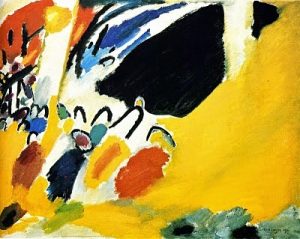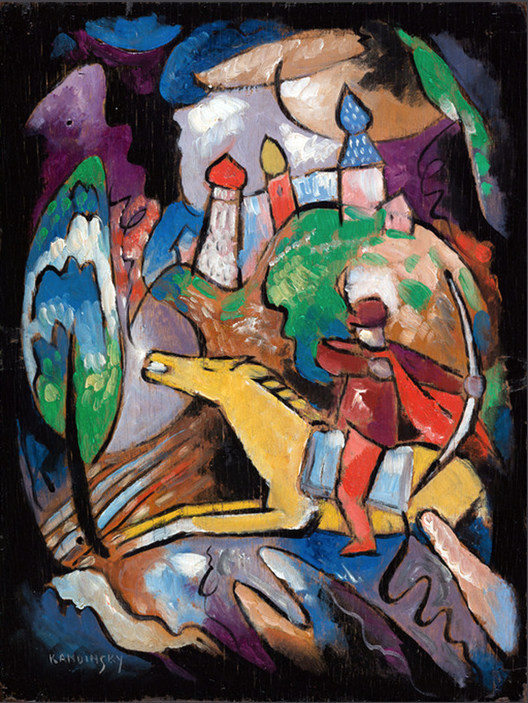Kandinsky’s Colorful Ride: Exploring Color Theory in “The Rider” (1909)
Wassily Kandinsky, a pioneer of abstract art, wasn’t just flinging paint onto canvases. He was a deep thinker, a synesthete (someone who experiences a blending of senses, like seeing colors when hearing music), and a revolutionary who developed a profound color theory that shaped modern art. Let’s saddle up and explore how Kandinsky’s ideas play out in his 1909 work, “The Rider.”
Kandinsky’s Core Color Concepts
Before diving into the painting, let’s outline the fundamental principles of Kandinsky’s color theory:

-
Color and Emotion: Kandinsky believed that color directly influences the soul. He saw colors as possessing their own distinct personalities and emotional impacts. Yellow, for example, was often associated with warmth, excitement, and even aggression, while blue represented depth, peace, and the spiritual.
-
Color Harmony and Contrast: Just like musical notes, colors could be combined harmoniously or used in jarring contrasts to evoke specific feelings. Complementary colors (like red and green) create vibrancy when juxtaposed, while analogous colors (those next to each other on the color wheel) offer a sense of calm and unity.
-
Color and Form: Kandinsky didn’t see color and form as separate entities. He believed they were intertwined, with form influencing how a color is perceived and vice versa. A sharp, angular form might amplify the aggression of red, while a soft, rounded form could enhance the peacefulness of blue.
-
The Spiritual in Art: Central to Kandinsky’s thinking was the idea that art should express inner spiritual truths rather than simply depicting the external world. Color was a key tool in achieving this spiritual resonance.
“The Rider” (1909) as a Case Study: A Step Towards Abstraction
In “The Rider” (1909), Kandinsky presents a rider on a yellow horse amidst a landscape featuring stylized buildings. What makes this painting particularly interesting is its place within Kandinsky’s timeline: painted before the formation of “Der Blaue Reiter” (The Blue Rider) group in 1911, it offers a glimpse into the development of his abstract and spiritual vision. Here’s how we can interpret the painting through the lens of his color ideas:
-
Precursor to “Der Blaue Reiter”: The painting demonstrates Kandinsky’s growing interest in moving away from representational art towards a more abstract and emotionally driven style. It anticipates the key themes and aesthetics that would define the “Der Blaue Reiter” movement.
-
Yellow as the dominant color: The striking yellow horse immediately draws the viewer’s eye. According to Kandinsky’s theory, yellow can represent excitement, warmth, and even aggression. The slightly unsettling nature of the yellow, combined with the rider, could suggest a journey into the unknown.
-
Contrast with Red: The rider is clothed in red and orange hues, further amplifying the sense of energy and perhaps passion or even conflict. This contrasts with the cooler blues and greens in the surrounding landscape, creating visual tension and adding depth to the composition.
-
The Spiritual element: The buildings in the background, topped with colorful towers, and the somewhat dreamlike, almost folk-art quality of the landscape suggest a spiritual dimension. While not fully abstract, the scene is far from a realistic depiction, inviting interpretation beyond the purely representational.
-
Interaction of Form and Color: The simplified, almost abstracted forms of the rider, horse, and landscape elements allow the colors to take center stage. The limited detail encourages the viewer to focus on the emotional impact of the colors themselves, rather than being tied to a literal interpretation of the scene.
Kandinsky’s Legacy
Kandinsky’s color theory was groundbreaking. “The Rider” (1909) is a key example of his transition towards abstraction and his focus on expressing inner spiritual truths through color. It foreshadows the artistic revolution that would soon follow with the “Der Blaue Reiter” movement.
By understanding his principles, we can appreciate not only the visual beauty of his work but also the deep emotional and spiritual meaning he sought to convey. So, the next time you look at “The Rider” (1909) or another Kandinsky painting, consider the colors, their relationships, and the emotions they evoke. You might just find yourself on a colorful ride into the depths of your own soul.

